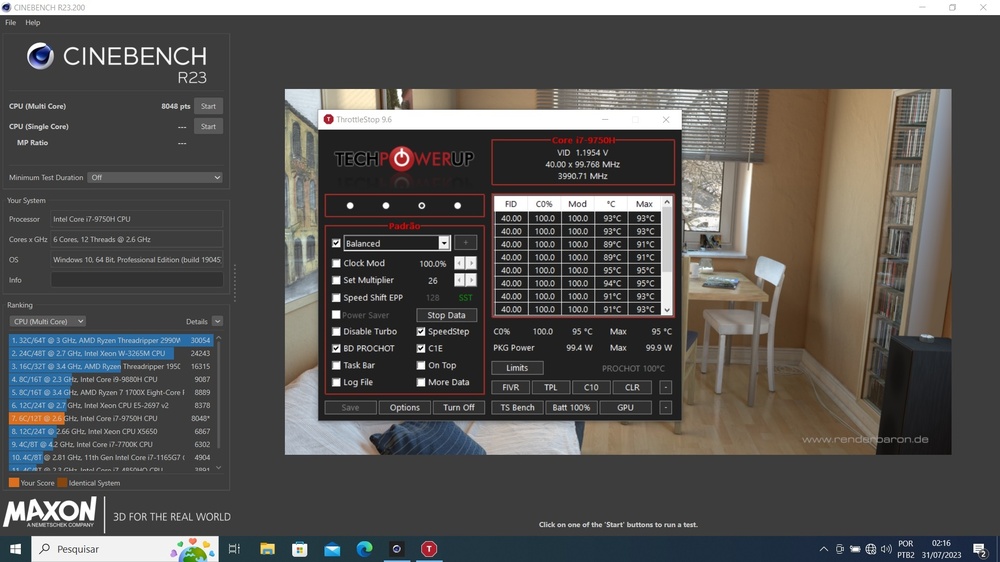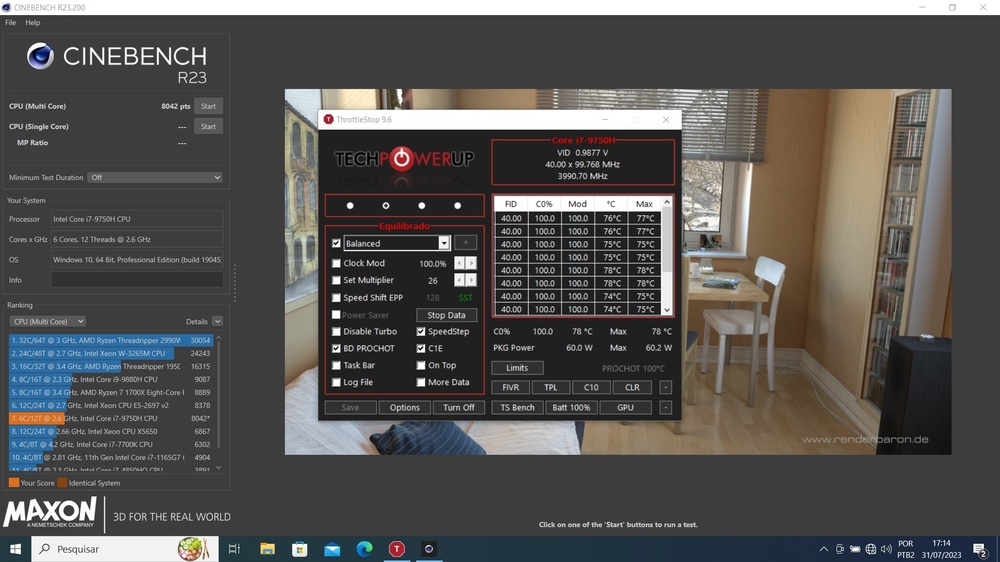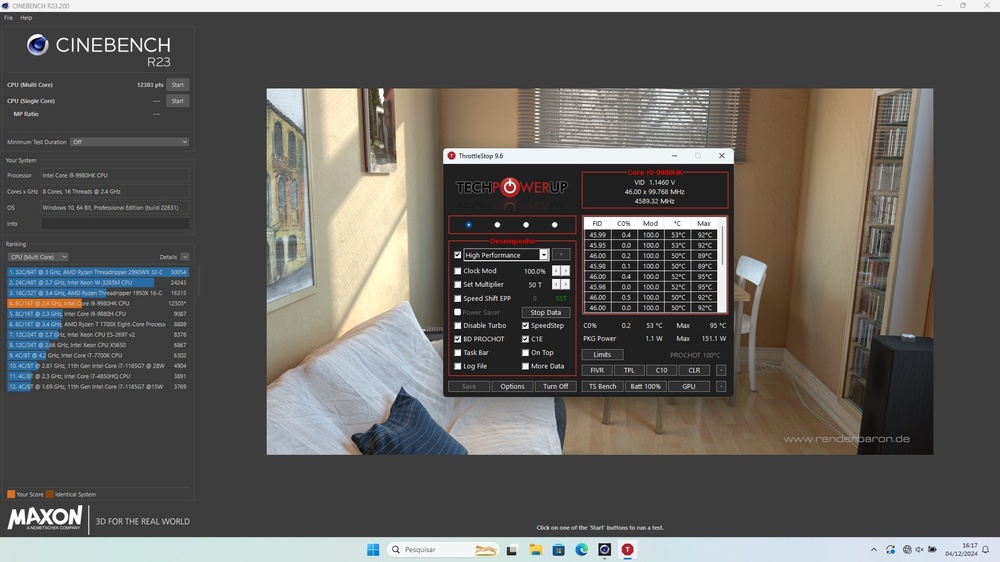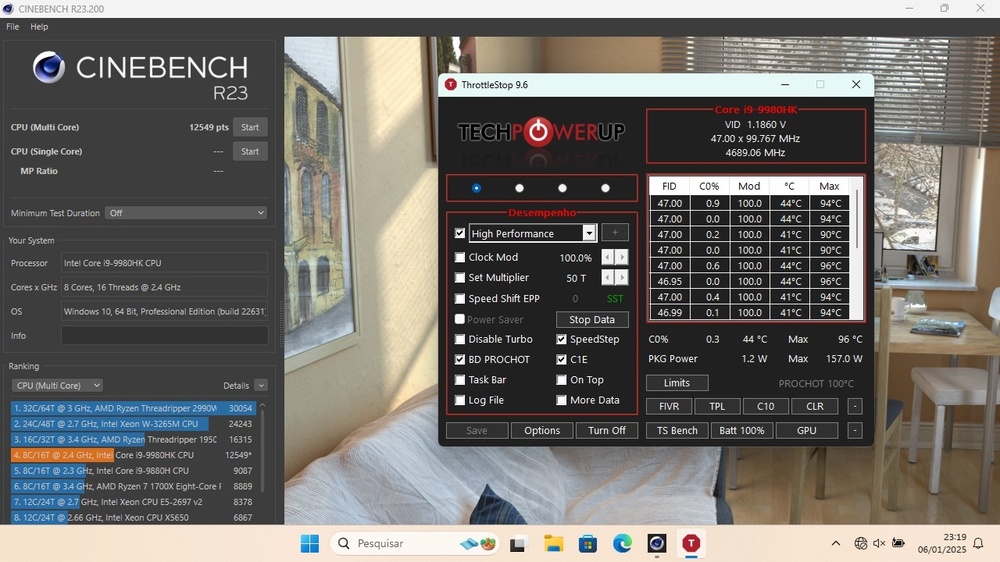
PHVM_BR
Member-
Posts
127 -
Joined
-
Last visited
Recent Profile Visitors
The recent visitors block is disabled and is not being shown to other users.
PHVM_BR's Achievements
-
Precision 7540 & Precision 7740 owner's thread
PHVM_BR replied to SvenC's topic in Pro Max & Precision Mobile Workstation
Simply download the VBIOS update firmware available in the driver list on the P7550 support page, extract its contents with 7zip, and click on the corresponding option (RTX 5000 or RTX 4000). The installation is automatic. https://www.dell.com/support/home/en-us/drivers/driversdetails?driverid=m1hhx&oscode=wt64a&productcode=precision-15-7550-laptop -
Precision 7540 & Precision 7740 owner's thread
PHVM_BR replied to SvenC's topic in Pro Max & Precision Mobile Workstation
My Precision is stored away; I've been using a newer laptop. Maybe this weekend... -
Precision 7540 & Precision 7740 owner's thread
PHVM_BR replied to SvenC's topic in Pro Max & Precision Mobile Workstation
I had an i7-9750H for four years, and it was completely stable at -125mV/-215mV for cache/core. With Speedshift = 0 (Windows power plan set to High Performance) I could maintain it at -135mV/-225mV. i7, i9, Xeon... I think it all depends on the silicon lottery. I agree that a 180W charger is sufficient for i7 (6-core) versions. -
Precision 7540 & Precision 7740 owner's thread
PHVM_BR replied to SvenC's topic in Pro Max & Precision Mobile Workstation
Not necessarily. Phase change pads better fill heat sink contact gaps. -
Precision 7540 & Precision 7740 owner's thread
PHVM_BR replied to SvenC's topic in Pro Max & Precision Mobile Workstation
Don't waste your time with Carbonaut because Kryosheet is much better. Your temperatures are fine, I wouldn't change anything if your CPU reaches max performance at 85°C at full load. On my Precision, Kryosheet provides up to ~15% more thermal headroom than the PTM 7950, but, as I mentioned earlier, it requires good contact between the heatsink and the CPU. I've tested Kryosheet on another laptop and didn't get good results due to uneven heatsink contact. You'll need to test it to find out. I like to drip a micro drop of thermal paste in 2 diagonals close to the CPU die so that the graphene sheet remains fixed. I forgot to mention, but I only use Kryosheet on the CPU. On the GPU, the phase change pad works great and is more than sufficient. Your CPU must be undervolted to achieve its full performance on this machine. On my old i7-9750H in Cinebench R23 to sustain 4.0GHz on all cores (maximum clock at full load): . without undervolt: ~100W at ~95°C and fans at 100% . with undervolt: ~60W at ~78°C and fans at ~75% -
Precision 7540 & Precision 7740 owner's thread
PHVM_BR replied to SvenC's topic in Pro Max & Precision Mobile Workstation
I tested almost everything available on the 7540's i9, including Gelid HeatPhase. In my tests, its performance falls short of the PTM 7950 or TG PhaseSheet, which are identical. The Gelid phase-change pad appears to be of lower quality, at least when I tested it. In any case, with an undervolt, your 7530 with Gelid HeatPhase should be able to deliver the full performance of the i7-8750H without difficulty. Before the i9-9980HK, my Precision originally came with an i7-9750H (very similar to the 8750H), and with a fully stable undervolt, it consumed a maximum of 60-61W to deliver its peak performance in Cinebench R23 (4.0GHz on all cores), and the temperature hovered around 80°C with the fans at ~75%. On my i9, Kryosheet can provide more thermal headroom than the PTM 7950, but this requires good heatsink contact. Otherwise, the phase change pad will be better... Always keep the air intake away from the tabletop with a laptop stand. It makes a big difference on these Precision laptops. -
Precision 7540 & Precision 7740 owner's thread
PHVM_BR replied to SvenC's topic in Pro Max & Precision Mobile Workstation
4.6GHz in one benchmark may be different from 4.6GHz in another. It depends on the intensity of the load. For example, sustaining 4.6GHz may require 100W in one benchmark and 150W in another. The more watts, the more heat. Try Cinebench R23 or 2024. The load is heavier. As for UserBenchmark, no one cares, so you won't have a basis for comparison. -
Precision 7540 & Precision 7740 owner's thread
PHVM_BR replied to SvenC's topic in Pro Max & Precision Mobile Workstation
Try another benchmark, nobody cares about userbenchmark. It's crap! -
Precision 7540 & Precision 7740 owner's thread
PHVM_BR replied to SvenC's topic in Pro Max & Precision Mobile Workstation
I'm using Kryosheet on the CPU and PTM 7950 on the GPU. I also tested PTM 7950 on the CPU, but its performance is lower compared to Kryosheet. The problem with Kryosheet is that the heatsink needs to make a perfect contact with the die, uniform, otherwise the performance will be equal or worse than PTM 7950. I have 2 heatsinks for the P7540, the original one for Quadro T2000 and the one I bought for RTX 4000. I can only get these 160W with the original heatsink because unfortunately with the new, 2 cores reach the thermal limit at ~130W in the short CBR23 test. About undervolt, my i9 is totally stable with -102mV for the cache and -170mV for the core. This is for Windows in Balanced mode, with Speedshift at 84, where the clocks vary constantly... In High Performance mode (Speedshift = 0), the stable undervolt varies according to the set clock and to use a more aggressive undervolt I need to set the same clock for all loads on all cores. On my i9, for 4.2 and 4.3GHz the stable undervolt is the one mentioned above, but above that I can extract more: 4.4GHz -120mV / -200mV 4.5GHz -140mV / -230mV 4.6GHz -150mV / -250mV 4.7GHz -135mV / -225mV One tip is that with the default IccMax (140A) the maximum power the CPU can use is ~120W, which on the CBR23 with undervolt is equivalent to ~4.4GHz on all cores. Above that, it is necessary to increase the IccMax of the core and cache. For normal use, I keep it at default, for intensive tasks with overclocking or for benchmarks I increase both to the maximum. -
Horrible! They ended up with strong names, consolidated, with the excuse of making it easier to identify the lines and put something totally generic.
-
https://videocardz.com/newz/alienware-brings-back-area-51-laptops-core-ultra-200hx-and-geforce-rtx-50-on-board
-
The 7670/7680 already have a TGP +100W. For the claimed 170W of CPU + GPU consumption I would bet on 55W + 115W with around 130/140W with Dynamic Boost.
-
https://www.notebookcheck.com/Dell-Pro-Max-16-und-Pro-Max-18-Plus-leaken-als-Flaggschiff-Laptops-mit-Tandem-OLED-und-drei-Lueftern.930490.0.html
-
Precision 7540 & Precision 7740 owner's thread
PHVM_BR replied to SvenC's topic in Pro Max & Precision Mobile Workstation
WTF! I never imagined that the Precision 7540 could do Cinebench R23 at 4.6GHz all core consuming +150W and without thermal throttling! In Cinebench 2024 which is a longer benchmark (~8 minutes vs ~1 minute in R23) I can sustain 4.5GHz consuming +130W reaching a maximum of ~92°C. Edit: At 4,7GHz all cores consuming 157W: -
precision 7530 Precision 7530 upgrade
PHVM_BR replied to Jers6410's topic in Pro Max & Precision Mobile Workstation
In Cinebench reducing it to -210mV you should see the clock increase with the temperature remaining the same as it will continue to consume 60W. Generally with Speedshift at 0 with high performance selected in the Throttlestop main window it is possible to increase the undervoltage. This occurs because the voltage x clock curve varies and generally at higher clocks it is possible to reduce the voltage a little more. With Speedshift at 0, the processor will always try to keep clocks at maximum, thus allowing greater undervoltage. Try setting High Performance in Throttlestop with -135mV in cache and -225mV in core. This will allow reaching higher clocks in Cinebench, probably close to the maximum clock possible on all CPU cores (4.1GHz) but probably still limited by the PL1 of 60W. The only way I know of getting around the EC power limit is by changing the IMON slope/IMON offset, but on the Precision 7540 I found that forcing the CPU for about 2 minutes at 92°C or more causes the power limit decrease even when changing IMON slope.





